The Driving Mechanisms on Southern Ocean Upwelling Change during the Last Deglaciation
Abstract
:1. Introduction
2. Model and Approaches
3. Results
3.1. Southern Ocean Upwelling Indicated by Proxy Records and in TraCE-21ka
3.2. The Mechanism of Zonal Mean Upwelling Changes in the Southern Ocean
3.3. The Mechanism of Local Ocean Upwelling Changes in the Southern Ocean
4. Conclusions and Discussion
Author Contributions
Funding
Institutional Review Board Statement
Informed Consent Statement
Data Availability Statement
Acknowledgments
Conflicts of Interest
References
- Toggweiler, J.R.; Russell, J.L.; Carson, S.R. Midlatitude westerlies, atmospheric CO2, and climate change during the ice ages. Paleoceanography 2006, 21, PA2005. [Google Scholar] [CrossRef] [Green Version]
- Anderson, R.F.; Ali, S.; Bradtmiller, L.; Fleisher, M.Q.; Burckle, L.H. Wind-driven upwelling in the Southern Ocean and the deglacial rise of atmospheric CO2. Science 2009, 323, 1443–1448. [Google Scholar] [CrossRef] [PubMed]
- Skinner, L.C.; Fallon, S.; Waelbroeck, C.; Michel, E.; Barker, S. Ventilation of the deep Southern Ocean and deglacial CO2 rise. Science 2010, 328, 1147–1151. [Google Scholar] [CrossRef] [PubMed]
- Sigman, D.; Hain, M.; Haug, G. The polar ocean and glacial cycles in atmospheric CO2 concentration. Nature 2006, 466, 47–55. [Google Scholar] [CrossRef] [PubMed]
- Ai, X.E.; Studer, A.S.; Sigman, D.M.; Martínez-García, A.; Fripiat, F.; Thöle, L.M.; Michel, E.; Gottschalk, J.; Arnold, L.; Moretti, S.; et al. Southern Ocean upwelling, Earth’s obliquity, and glacial-interglacial atmospheric CO2 change. Science 2020, 370, 1348–1352. [Google Scholar] [CrossRef] [PubMed]
- Delmas, R.J.; Ascencio, J.-M.; Legrand, M. Polar ice evidence that atmospheric CO2 29,000 years B.P. was 50% of the present. Nature 1980, 282, 155–157. [Google Scholar] [CrossRef]
- Neftel, A.; Oeschger, H.; Schwander, J.; Stauffer, B.; Zumbrunn, R. Ice core sample measurements give atmospheric CO2 contents during the past 40,000 years. Nature 1982, 295, 220–223. [Google Scholar] [CrossRef]
- Moore, J.K.; Abbott, M.R.; Richman, J.G.; Nelson, D.M. The Southern Ocean at the last glacial maximum: A strong sink for atmospheric carbon dioxide. Global Biogeochem. Cycles 2000, 14, 455–475. [Google Scholar] [CrossRef] [Green Version]
- Lauderdale, J.M.; Williams, R.G.; Munday, D.R.; Marshall, D.P. The impact of Southern Ocean residual upwelling on atmospheric CO2 on centennial and millennial timescales. Clim. Dyn. 2017, 48, 1611–1631. [Google Scholar] [CrossRef] [Green Version]
- Menviel, L.; Spence, P.; Yu, J.; Chamberlain, M.A.; Matear, R.J.; Meissner, K.J.; England, M.H. Southern Hemisphere westerlies as a driver of the early deglacial atmospheric CO2 rise. Nat. Commun. 2018, 9, 1–12. [Google Scholar] [CrossRef] [Green Version]
- Heusser, C.J. Southern westerlies during the last glacial maximum. Quat Res. 1989, 31, 423–425. [Google Scholar] [CrossRef]
- Lamy, F.; Hebbeln, D.; Wefer, G. High-resolution marine record of climatic change in mid-latitude Chile during the last 28,000 years based on terrigenous sediment parameters. Quat. Res. 1999, 51, 83–93. [Google Scholar] [CrossRef]
- Heusser, L.; Heusser, C.J.; Mix, A.; McManus, J. Chilean and Southeast Pacific paleoclimate variations during the last glacial cycle: Directly correlated pollen and δ18O records from ODP Site 1234. Quat. Sci. Rev. 2006, 25, 3404–3415. [Google Scholar] [CrossRef]
- Heusser, L.; Heusser, C.J.; Pisias, N. Vegetation and climate dynamics of southern Chile during the past 50,000 years: Results of ODP Site 1233 pollen analysis. Quat. Sci. Rev. 2006, 25, 474–485. [Google Scholar] [CrossRef]
- Mc Glone, M.; Turney, C.S.M.; Wilmshurst, J.M.; Renwick, J.; Pahnke, K. Divergent trends in land and ocean temperature in the Southern Ocean over the past 18,000 years. Nat. Geosci. 2010, 3, 622–626. [Google Scholar] [CrossRef]
- Kohfeld, K.E.; Graham, R.M.; de Boer, A.M.; Sime, L.C.; Wolff, E.W.; Le Quéré, C.; Bopp, L. Southern Hemisphere westerly wind changes during the Last Glacial Maximum: Paleo-data synthesis. Quat. Sci. Rev. 2013, 68, 76–95. [Google Scholar] [CrossRef]
- Markgraf, V. Late and postglacial vegetational and paleoclimatic changes in subantarctic, temperate, and arid environments in Argentina. Palynology 1983, 7, 43–70. [Google Scholar] [CrossRef]
- Markgraf, V.; Bradbury, J.P.; Busby, J.R. Palaeoclimates in southwestern Tasmania during the last 13,000 years. Palaios 1986, 1, 368–380. [Google Scholar] [CrossRef] [Green Version]
- Markgraf, V. Paleoclimates in central and South America since 18,000 BP based on pollen and lake-level records. Quat. Sci. Rev. 1989, 8, 1–24. [Google Scholar] [CrossRef]
- Petit, J.R.; Jouzel, J.; Raynaud, D.; Barkov, N.I.; Barnola, J.M.; Basile, I.; Bender, M.; Chappellaz, J.; Davis, M.; Delaygue, G.; et al. Climate and atmospheric history of the past 420,000 years from the Vostok ice core, Antarctica. Nature 1999, 399, 429–436. [Google Scholar] [CrossRef] [Green Version]
- Delmonte, B.; Petit, J.R.; Maggi, V. Glacial to Holocene implications of the new 27000-year dust record from the EPICA Dome C (East Antarctica) ice core. Clim. Dyn. 2002, 18, 647–660. [Google Scholar]
- Wolff, E.W.; Fischer, H.; Fundel, F.; Ruth, U.; Twarloh, B.; Littot, G.C.; Mulvaney, R.; Röthlisberger, R.; de Angelis, M.; Boutron, C.F.; et al. Southern Ocean sea-ice extent, productivity and iron flux over the past eight glacial cycles. Nature 2002, 440, 491–496. [Google Scholar] [CrossRef] [PubMed]
- Williams, N.J.; Harle, K.J.; Gale, S.J.; Heijnis, H. The vegetation history of the last glacial-interglacial cycle in eastern New South Wales, Australia. J. Quat. Sci. 2006, 21, 735–750. [Google Scholar] [CrossRef]
- Rojas, M.; Moreno, P.; Kageyama, M.; Crucifix, M.; Hewitt, C.; Abe-Ouchi, A.; Ohgaito, R.; Brady, E.C.; Hope, P. The southern westerlies during the last glacial maximum in PMIP2 simulations. Clim. Dyn. 2009, 32, 525–548. [Google Scholar] [CrossRef]
- Chavaillaz, Y.; Codron, F.; Kageyama, M. Southern westerlies in LGM and future (RCP4.5) climates. Clim. Past 2013, 9, 517–524. [Google Scholar] [CrossRef] [Green Version]
- Rojas, M. Sensitivity of Southern Hemisphere circulation to LGM and 4×CO2 climates. Geophys. Res. Lett. 2013, 40, 1–6. [Google Scholar] [CrossRef]
- Sime, L.C.; Kohfeld, K.E.; Le Quéré, C.; Wolff, E.W.; de Boer, A.M.; Graham, R.M.; Bopp, L. Southern Hemisphere westerly wind changes during the Last Glacial Maximum: Model-data comparison. Quat. Sci. Rev. 2013, 64, 104–120. [Google Scholar] [CrossRef] [Green Version]
- Liu, W.; Lu, J.; Leung, L.R.; Xie, S.-P.; Liu, Z.; Zhu, J. The de-correlation of westerly winds and westerly-wind stress over the Southern Ocean during the Last Glacial Maximum. Clim. Past 2015, 11, 3157–3168. [Google Scholar] [CrossRef]
- Sime, L.C.; Hodgson, D.; Bracegirdle, T.J.; Allen, C.; Perren, B.; Roberts, S. Sea ice led to poleward-shifted winds at the Last Glacial Maximum: The influence of state dependency on CMIP5 and PMIP3 models. Clim. Past 2016, 12, 2241–2253. [Google Scholar] [CrossRef] [Green Version]
- Otto-Bliesner, B.; Brady, E.; Clauzet, G.; Thomas, R.; Levis, S.; Kothavala, Z. Last glacial maximum and Holocene climate in CCSM3. J. Clim. 2006, 19, 2526–2544. [Google Scholar] [CrossRef] [Green Version]
- Dezileau, L.; Bareille, G.; Reyss, J.L. The 231Pa/230Th ratio as a proxy for past changes in opal fluxes in the Indian sector of the Southern Ocean. Mar. Chem. 2003, 81, 105–117. [Google Scholar] [CrossRef]
- Chase, Z.; Anderson, R.; Fleisher, M.; Kubik, P. Accumulation of biogenic and lithogenic material in the Pacific sector of the Southern Ocean during the past 40,000 years. Deep Sea Res. Part II 2003, 50, 799–832. [Google Scholar] [CrossRef]
- Liu, Z.; Otto-Bliesner, B.L.; He, F.; Brady, E.C.; Tomas, R.; Clark, P.U.; Carlson, A.E.; Lynch-Stieglitz, J.; Curry, W.; Brook, E.; et al. Transient simulation of last deglaciation with a new mechanism for Bølling-Allerød warming. Science 2009, 325, 310–314. [Google Scholar] [CrossRef] [Green Version]
- Olbers, D. Comments on “On the obscurantist physics of ’form drag’ in theorizing about the Circumpolar Current”. J. Phys. Oceanogr. 1998, 28, 1647–1654. [Google Scholar] [CrossRef]
- Rintoul, S.; Hughes, C.; Olbers, D. Ocean Circulation and Climate. In The Antarctic Circumpolar Current System; Siedler, G., Church, J., Gould, J., Eds.; International Geophysics Series; Academic Press: Cambridge, MA, USA, 2001; Volume 77, pp. 271–302. [Google Scholar]
- Collins, W.D.; Bitz, C.M.; Blackmon, M.L.; Bonan, G.B.; Bretherton, C.S.; Carton, J.A.; Chang, P.; Doney, S.C.; Hack, J.J.; Henderson, T.B.; et al. The community climate system model version 3 (CCSM3). J. Clim. 2006, 19, 2122–2143. [Google Scholar] [CrossRef]
- Yeager, S.G.; Shields, C.A.; Large, W.G.; Hack, J.J. The low-resolution CCSM3. J. Clim. 2006, 19, 2545–2566. [Google Scholar] [CrossRef]
- Collins, W.D.; Rasch, P.J.; Boville, B.A.; Hack, J.J.; McCaa, J.R.; Williamson, D.L.; Briegleb, B.P.; Bitz, C.M.; Lin, S.-J.; Zhang, M. The formulation and atmospheric simulation of the Community Atmosphere Model version 3 (CAM3). J. Clim. 2006, 19, 2144–2161. [Google Scholar] [CrossRef] [Green Version]
- Dickinson, R.E.; Oleson, K.W.; Bonan, G.; Hoffman, F.; Thornton, P.; Vertenstein, M.; Yang, Z.L.; Zeng, X. The Community Land Model and its climate statistics as a component of the Community Climate System Model. J. Clim. 2006, 19, 2302–2324. [Google Scholar] [CrossRef]
- Briegleb, B.P.; Bitz, C.M.; Hunke, E.C.; Lipscomb, W.H.; Holland, M.M.; Schramm, J.L.; Moritz, R.E. Scientific Description of the Sea Ice Component in the Community Climate System Model; Version Three. Tech. Rep. NCAR/TN-463+STR; National Center for Atmospheric Research: Boulder, CO, USA, 2004; pp. 1–78. [Google Scholar]
- Smith, R.D.; Gent, P.R. (Eds.) Reference Manual for the Parallel Ocean Program (POP), Ocean Component of the Community Climate System Model (CCSM2.0 and 3.0); Tech. Rep., LA-UR-02-2484; Los Alamos National Laboratory: Los Alamos, NM, USA; National Center for Atmospheric Research: Boulder, CO, USA, 2002; pp. 1–76. [Google Scholar]
- He, F. Simulating Transient Climate Evolution of the Last Deglaciation with CCSM3. Ph.D. Thesis, University of Wisconsin-Madison, Madison, WI, USA, 2011. [Google Scholar]
- Shakun, J.D.; Clark, P.U.; He, F.; Marcott, S.A.; Mix, A.C.; Liu, Z.; Otto-Bliesner, B.; Schmittner, A.; Bard, E. Global warming preceded by increasing carbon dioxide concentrations during the last deglaciation. Nature 2006, 484, 49–54. [Google Scholar] [CrossRef]
- Liu, W.; Liu, Z.; Cheng, J.; Hu, H. On the stability of the Atlantic meridional overturning circulation during the last deglaciation. Clim. Dyn. 2015, 44, 1257–1275. [Google Scholar] [CrossRef]
- Berger, A. Long-term variations of daily insolation and Quaternary climatic changes. J. Atmos. Sci. 1978, 35, 2362–2367. [Google Scholar] [CrossRef]
- Joos, F.; Spahni, R. Rates of change in natural and anthropogenic radiative forcing over the past 20,000 years. Proc. Natl. Acad. Sci. USA 2008, 105, 1425–1430. [Google Scholar] [CrossRef] [Green Version]
- McManus, J.F.; Francois, R.; Gherardi, J.M.; Keigwin, L.D.; Brown-Leger, S. Collapse and rapid resumption of Atlantic meridional circulation linked to deglacial climate changes. Nature 2004, 428, 834–837. [Google Scholar] [CrossRef]
- Sarmiento, J.L.; Nicolas, G. Ocean Biogeochemical Dynamics; Princeton University Press: Princeton, NJ, USA, 2006; Volume 1015, pp. 1–528. [Google Scholar]
- Marshall, D. Topographic steering of the Antarctic Circumpolar Current. J. Phys. Oceanogr. 1995, 25, 1636–1650. [Google Scholar] [CrossRef] [Green Version]
- Gille, S. The Southern Ocean momentum balance: Evidence for topographic effects from numerical model output and altimeter data. J. Phys. Oceanogr. 1997, 27, 2219–2231. [Google Scholar] [CrossRef] [Green Version]
- Bryan, F.O. Parameter sensitivity of primitive equation ocean general circulation models. J. Phys. Oceanogr. 1987, 17, 970–985. [Google Scholar] [CrossRef] [Green Version]
- Broecker, W.S. Paleocean circulation during the last deglaciation: A bipolar seesaw? Paleoceanography 1998, 13, 119–121. [Google Scholar] [CrossRef]
- Alley, R.B.; Clark, P.U. The deglaciation of the northern hemisphere: A global perspective. Annu. Rev. Earth Planet. Sci. 1999, 27, 149–182. [Google Scholar] [CrossRef] [Green Version]
- Anderson, J.B.; Shipp, S.S.; Lowe, A.L.; Wellner, J.S.; Mosola, A.B. The Antarctic Ice Sheet during the Last Glacial Maximum and its subsequent retreat history: A review. Quat. Sci. Rev. 2002, 21, 49–71. [Google Scholar] [CrossRef]
- Curry, W.B.; Oppo, D.W. Glacial water mass geometry and the distribution of δ13C of ΣCO2 in the western Atlantic Ocean. Paleoceanography 2002, 20, PA1017. [Google Scholar]
- Adkins, J.F. The role of deep ocean circulation in setting glacial climates. Paleoceanography 2013, 28, 539–561. [Google Scholar] [CrossRef] [Green Version]
- Shin, S.-I.; Liu, Z.; Otto-Bliesner, B.; Brady, E.; Kutzbach, J.; Harrison, S. A Simulation of the Last Glacial Maximum climate using the NCAR?CCSM. Clim. Dyn. 2003, 20, 127–151. [Google Scholar] [CrossRef]
- Liu, Z.; Shin, S.-I.; Webb, R.S.; Lewis, W.; Otto-Bliesner, B.L. Atmospheric CO2 forcing on glacial thermohaline circulation and climate. Geophys. Res. Lett. 2005, 32, L02706. [Google Scholar] [CrossRef]
- Ferrari, R.; Jansen, M.F.; Adkins, J.F.; Burke, A.; Stewart, A.L.; Thompson, A.F. Antarctic sea ice control on ocean circulation in present and glacial climates. Proc. Natl. Acad. Sci. USA 2014, 111, 8753–8758. [Google Scholar] [CrossRef] [Green Version]
- Watson, A.J.; Vallis, G.K.; Nikurashin, M. Southern Ocean buoyancy forcing of ocean ventilation and glacial atmospheric CO2. Nat. Geosci. 2015, 8, 861–864. [Google Scholar] [CrossRef] [Green Version]
- Jansen, M.F.; Nadeau, L.P. The effect of Southern Ocean surface buoyancy loss on the deep-ocean circulation and stratification. J. Phys. Oceanogr. 2016, 46, 3455–3470. [Google Scholar] [CrossRef]
- Sun, S.; Eisenman, I.; Stewart, A. The influence of Southern Ocean surface buoyancy forcing on glacial-interglacial changes in the global deep ocean stratification. Geophys. Res. Lett. 2016, 43, 8124–8132. [Google Scholar] [CrossRef]
- Jansen, M.F. Glacial ocean circulation and stratification explained by reduced atmospheric temperature. Proc. Natl. Acad. Sci. USA 2017, 114, 45–50. [Google Scholar] [CrossRef] [Green Version]
- Marzocchi, A.; Jansen, M.F. Connecting Antarctic sea ice to deep?ocean circulation in modern and glacial climate simulations. Geophys. Res. Lett. 2017, 44, 6286–6295. [Google Scholar] [CrossRef]
- Sun, S.; Eisenman, I.; Stewart, A. Does southern ocean surface forcing shape the global ocean overturning circulation? Geophys. Res. Lett. 2018, 45, 2413–2423. [Google Scholar] [CrossRef] [Green Version]
- Marzocchi, A.; Jansen, M.F. Global cooling linked to increased glacial carbon storage via changes in Antarctic sea ice. Nat. Geosci. 2019, 12, 1001–1005. [Google Scholar] [CrossRef]
- Nadeau, L.P.; Ferrari, R.; Jansen, M.F. Antarctic sea ice control on the depth of North Atlantic deep water. J. Clim. 2019, 32, 2537–2551. [Google Scholar] [CrossRef]
- Karsten, R.; Marshall, J. Constructing the residual circulation of the Antarctic Circulation Current from observations. J. Phys. Oceanogr. 2002, 32, 3315–3327. [Google Scholar] [CrossRef] [Green Version]
- Marshall, J.; Speer, K. Closure of the meridional overturning circulation through Southern Ocean upwelling. Nat. Geosci. 2012, 5, 171–180. [Google Scholar] [CrossRef] [Green Version]
- d’Orgeville, M.N.; Sijp, W.P.; England, M.H.; Meissner, K.J. On the control of glacial?interglacial atmospheric CO2 variations by the Southern Hemisphere westerlies. Geophys. Res. Lett. 2010, 37, L21703. [Google Scholar]
- Völker, C.; Köhler, P. Responses of ocean circulation and carbon cycle to changes in the position of the Southern Hemisphere westerlies at Last Glacial Maximum. Paleoceanography 2013, 28, 726–739. [Google Scholar] [CrossRef] [Green Version]
- Tschumi, T.; Joos, F.; Parekh, P. How important are the Southern Hemisphere wind changes for low glacial carbon dioxide? Paleoceanography 2013, 34, PA4208. [Google Scholar]
- François, R.; Altabet, M.A.; Yu, E.-F.; Sigman, D.M.; Bacon, M.P.; Frank, M.; Bohrmann, G.; Bareille, G.; Labeyrie, L.D. Contribution of Southern Ocean surface-water stratification to low atmospheric CO2 concentrations during the last glacial period. Nature 1997, 389, 929–935. [Google Scholar] [CrossRef]


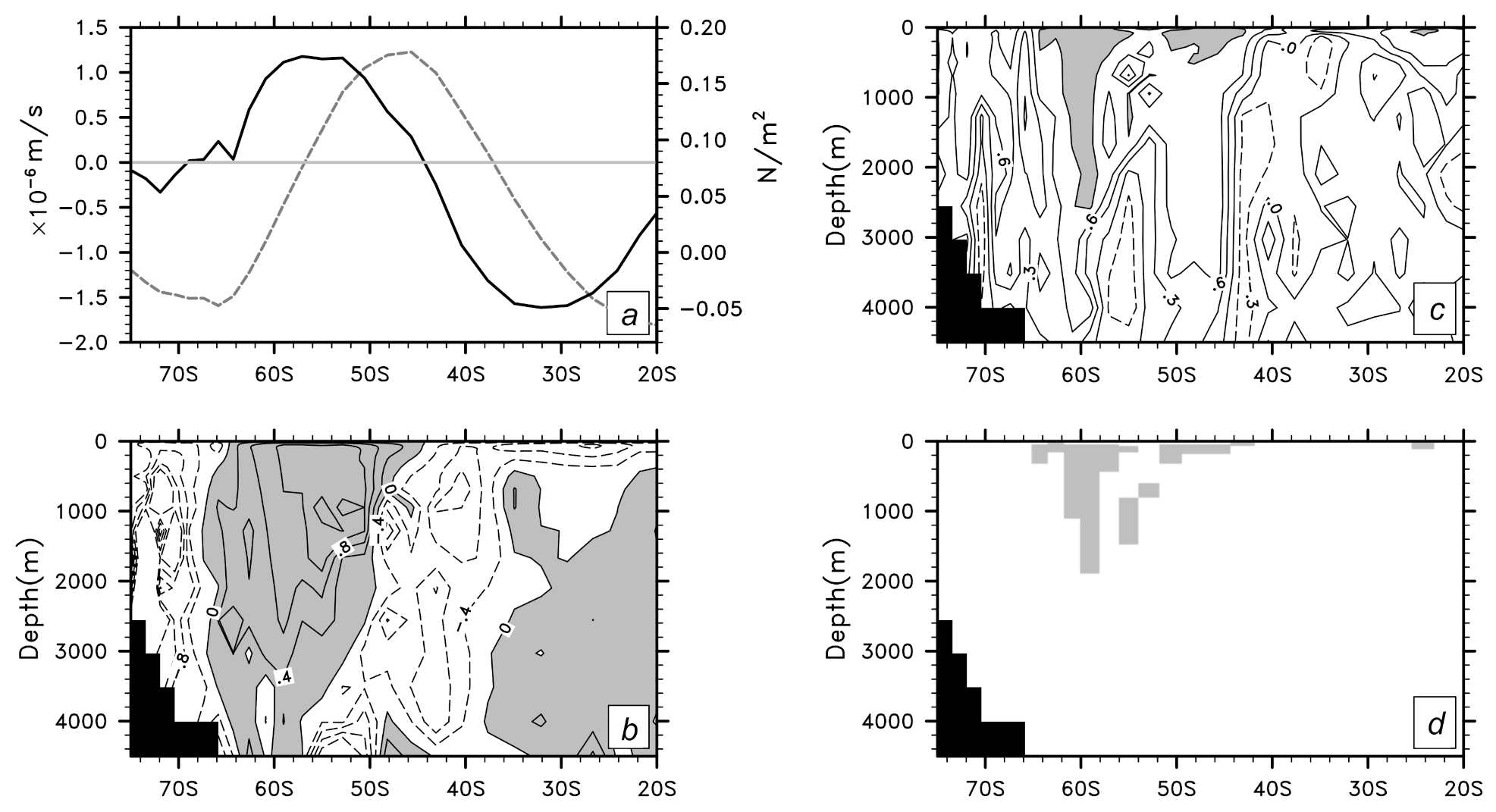
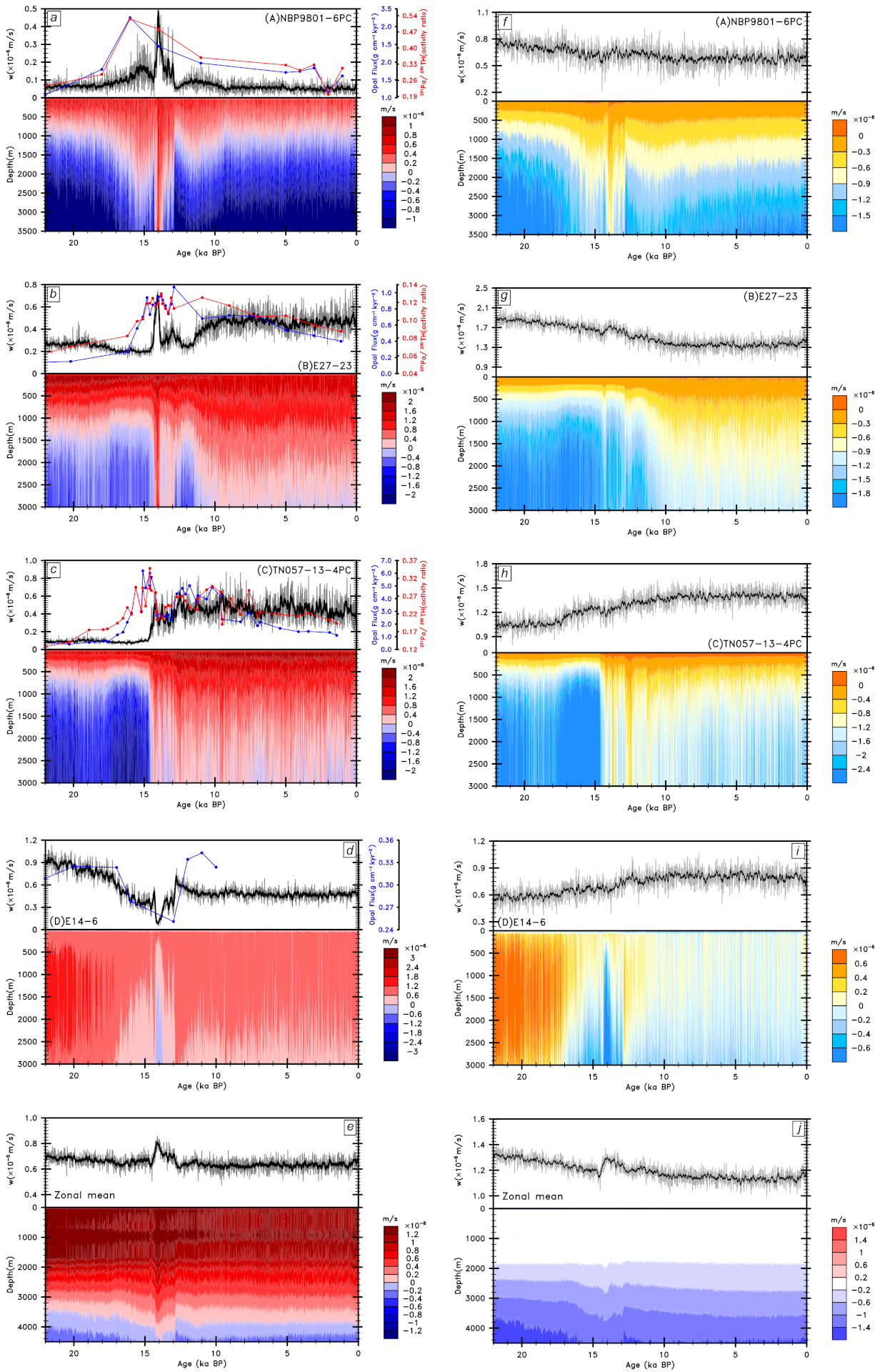
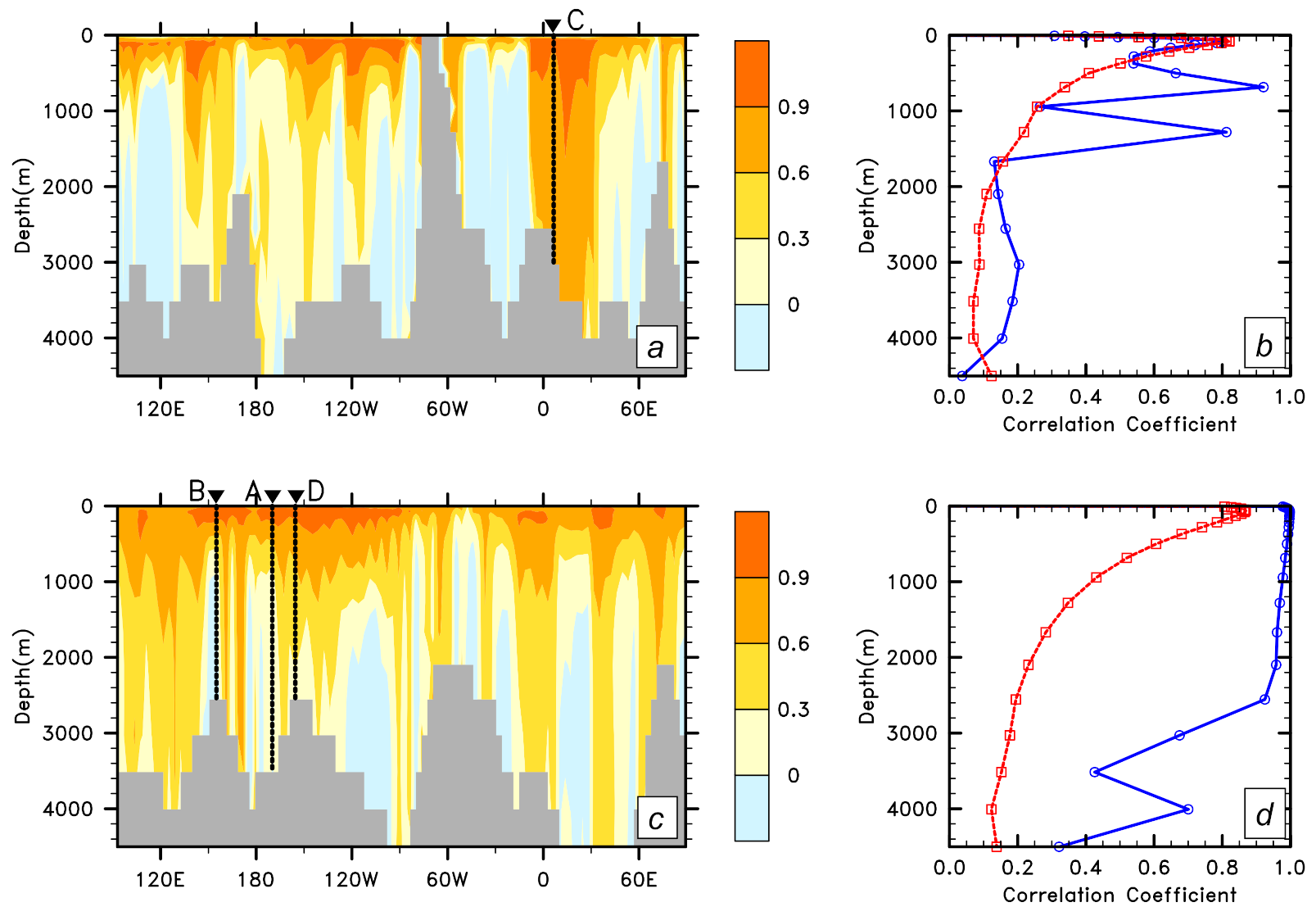
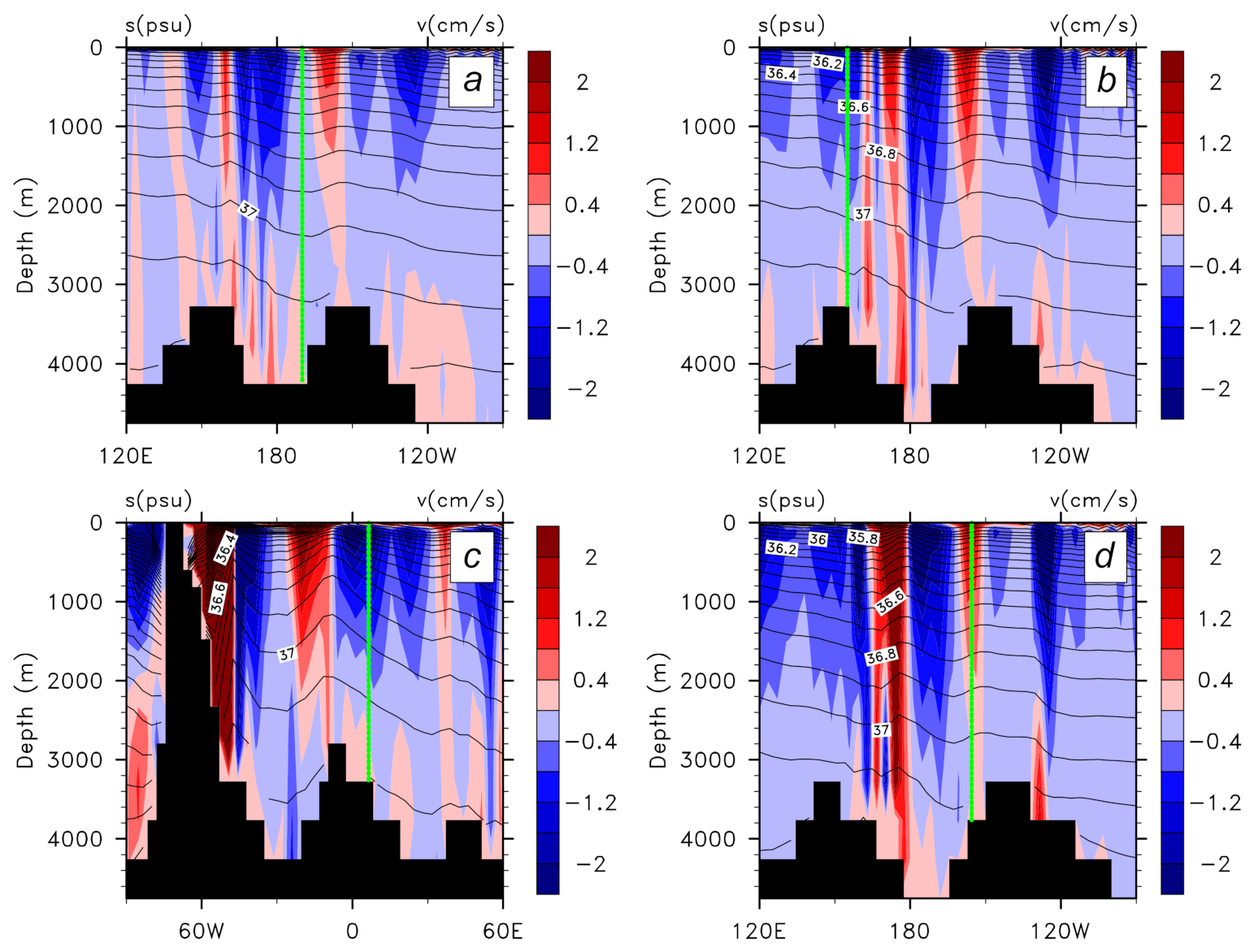
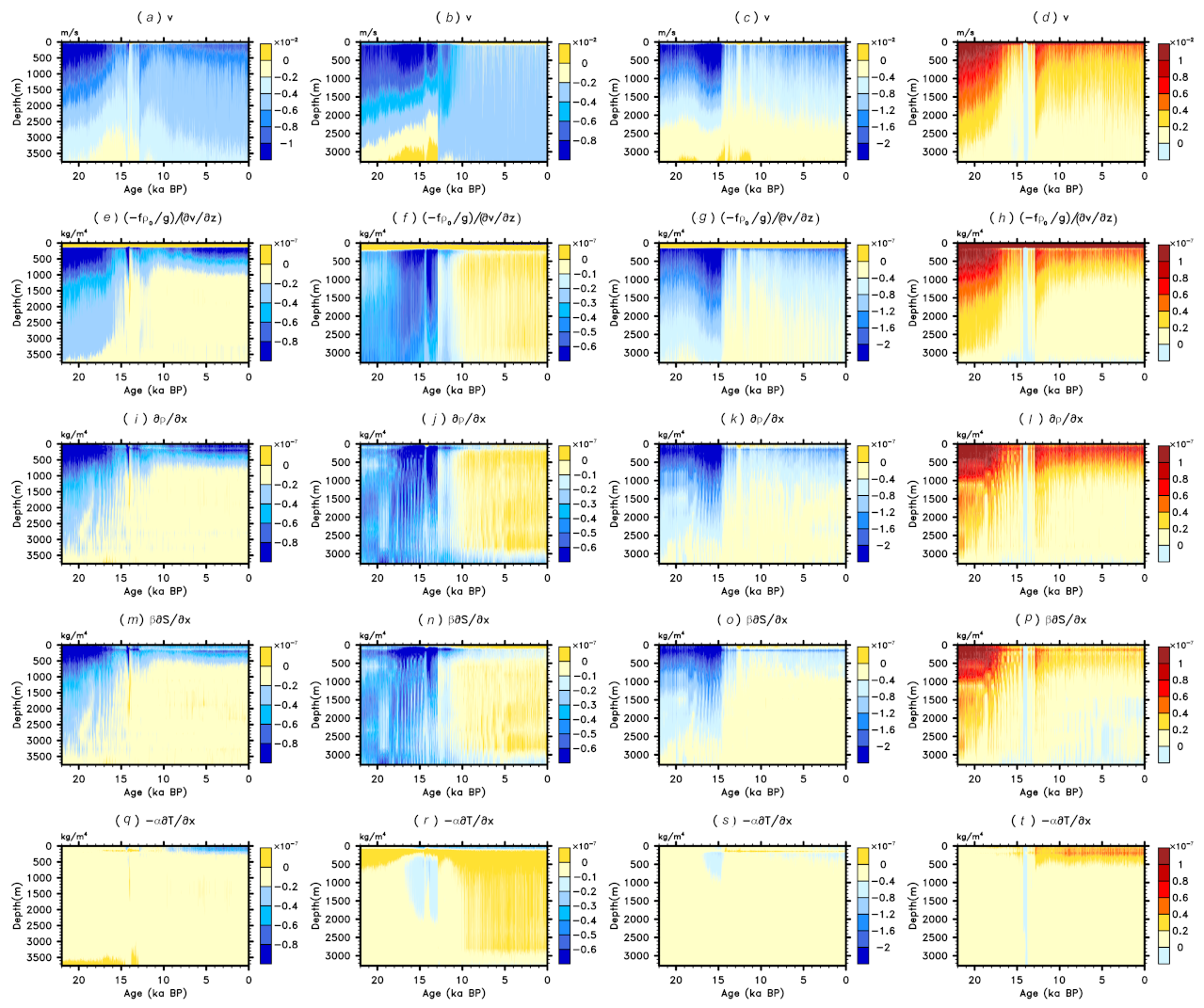
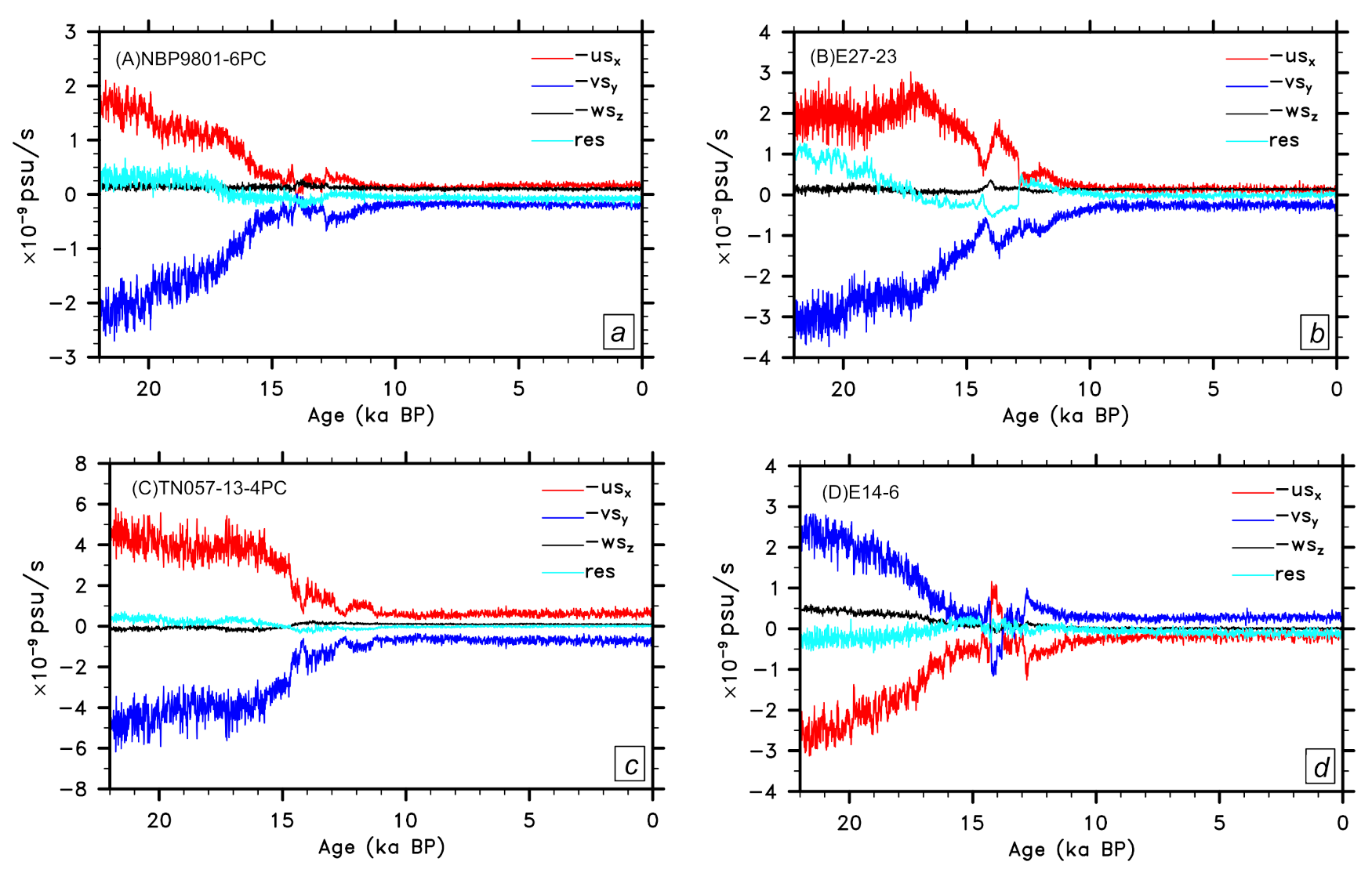
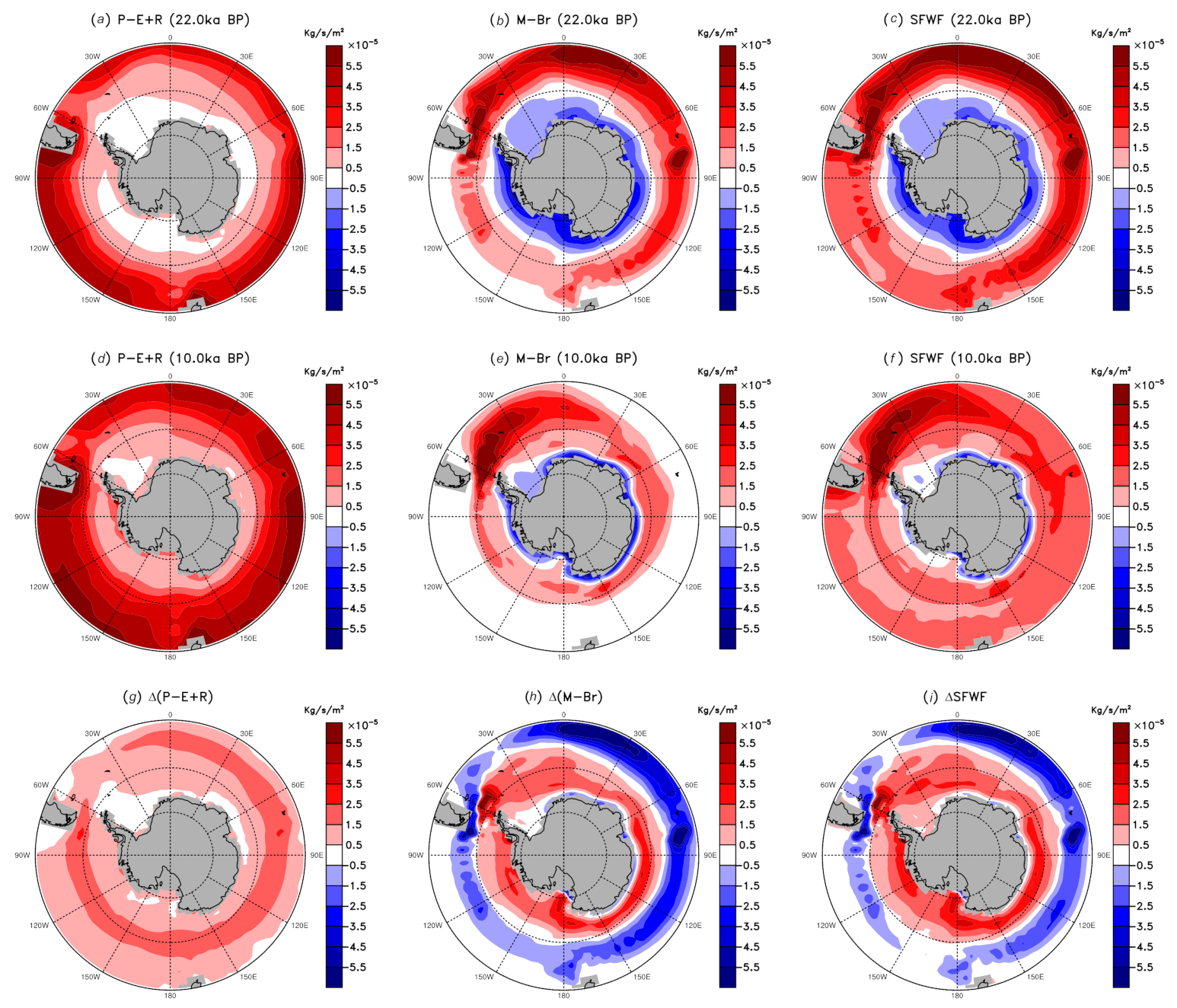
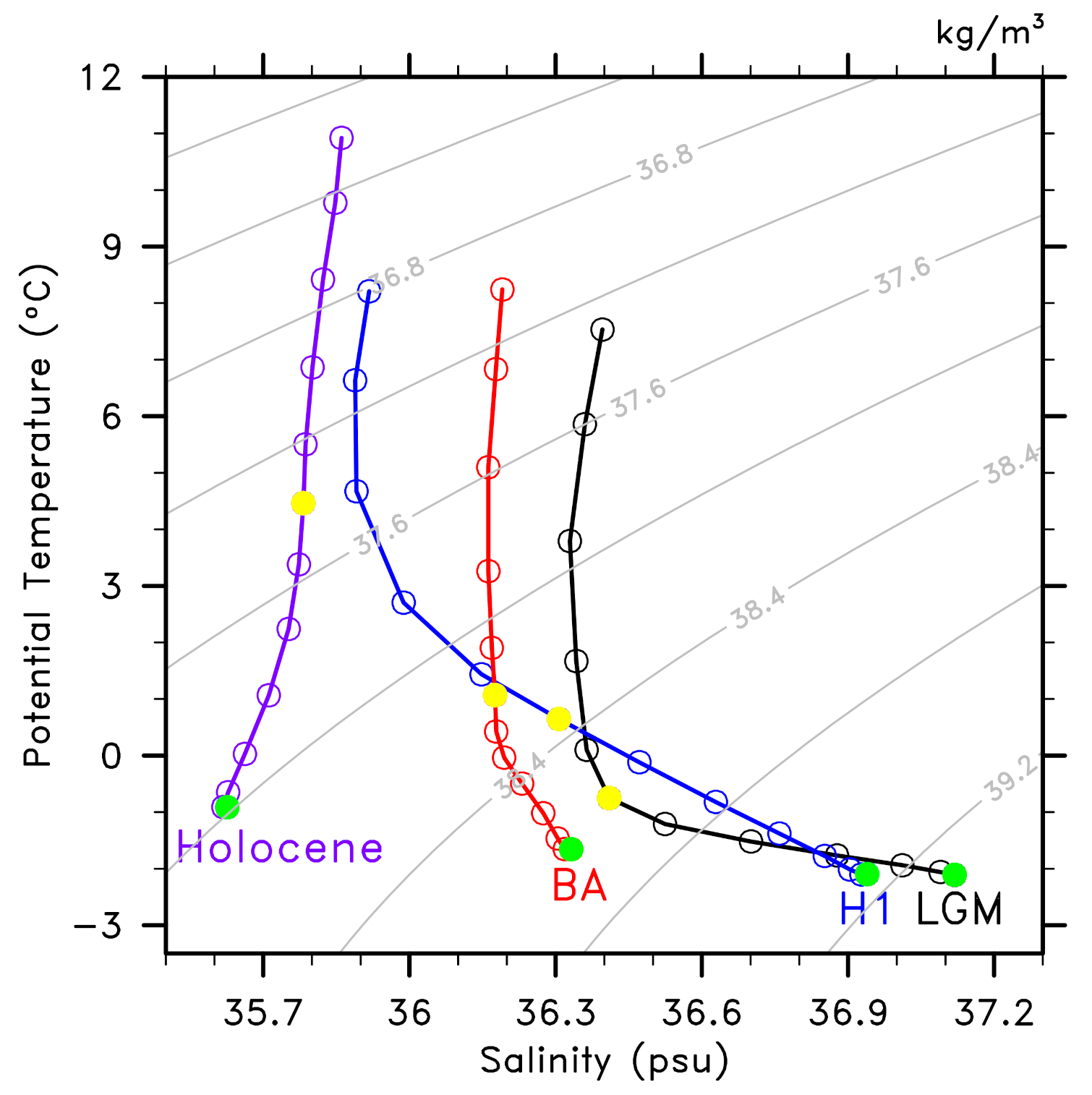
Publisher’s Note: MDPI stays neutral with regard to jurisdictional claims in published maps and institutional affiliations. |
© 2021 by the authors. Licensee MDPI, Basel, Switzerland. This article is an open access article distributed under the terms and conditions of the Creative Commons Attribution (CC BY) license (https://creativecommons.org/licenses/by/4.0/).
Share and Cite
Liu, W.; Liu, Z.; Li, S. The Driving Mechanisms on Southern Ocean Upwelling Change during the Last Deglaciation. Geosciences 2021, 11, 266. https://doi.org/10.3390/geosciences11070266
Liu W, Liu Z, Li S. The Driving Mechanisms on Southern Ocean Upwelling Change during the Last Deglaciation. Geosciences. 2021; 11(7):266. https://doi.org/10.3390/geosciences11070266
Chicago/Turabian StyleLiu, Wei, Zhengyu Liu, and Shouwei Li. 2021. "The Driving Mechanisms on Southern Ocean Upwelling Change during the Last Deglaciation" Geosciences 11, no. 7: 266. https://doi.org/10.3390/geosciences11070266




